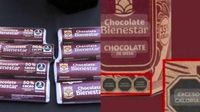On April 3, 2025, President Claudia Sheinbaum Pardo unveiled a new product called the Chocolate del Bienestar, sparking considerable debate over its health implications. The chocolate, designed to support national cacao producers, comes with three warning labels indicating excess calories, sugars, and saturated fats. This has raised eyebrows, particularly given Sheinbaum's ongoing efforts to eliminate junk food sales in schools across Mexico.
During her morning press conference, Sheinbaum was questioned about the sugar content of the Chocolate del Bienestar. She stated, "It has a low sugar content. It needs to be included because that’s how the regulation is, but compared to commercial chocolates, it has much less. That’s important because, of course, the Chocolate Bienestar is not going to promote sugar consumption, right? But it does have a little sugar, and how the regulation is, it has to have the labels." This statement reflects a significant aspect of the product's marketing strategy, positioning it as a healthier alternative.
María Luisa Albores, the Director of Alimentación para el Bienestar, elaborated on the product's characteristics. She confirmed that the Chocolate del Bienestar will be available in three formats: table chocolate, bars, and powdered chocolate primarily for preparing beverages. Albores emphasized the goal of providing a high-quality product that supports local cacao producers, stating, "In the case of a cacao processing plant, we seek to produce at least the three formats we are promoting: table chocolate, candy bars, and powder, mainly intended for preparing drinks with milk."
While the chocolate's sugar content is a focal point of discussion, it is essential to understand the context of the warning labels. In Mexico, products containing less than 5 grams of sugar per 100 grams of solids or 2.5 grams per 100 milliliters of liquids are considered low in sugar. Conversely, products exceeding 22.5 grams of sugar per 100 grams or 100 milliliters are required to carry an excess sugar label. Although Sheinbaum did not specify the exact sugar content of the Chocolate del Bienestar, it is clear that it must meet these regulatory standards.
Critics have raised concerns about the chocolate's branding, especially in light of the government's recent prohibition on selling junk food in schools. The policy, which affects over 258,000 educational institutions, aims to promote healthier eating habits among children and combat childhood obesity. Sheinbaum defended the Chocolate del Bienestar's inclusion of warning labels, arguing that the product is still a better choice compared to many commercial chocolates available on the market. She remarked, "It has a higher cacao content than those chocolates sold in convenience stores, which now have minimal cacao percentages and contain a lot of fat and artificial colorings."
In her defense of the chocolate, Sheinbaum also criticized a judge who recently granted injunctions against the Vida Saludable project aimed at promoting healthy eating in schools. She stated, "It is not possible for a judge to grant a suspension against a norm that seeks to prevent children from consuming junk food in schools. It shouldn't be." This remark highlights the ongoing tension between public health initiatives and legal challenges that aim to protect the availability of certain food products.
The Chocolate del Bienestar is part of a broader initiative by the Mexican government to provide affordable and nutritious food options to its citizens, particularly in the face of rising obesity rates. According to recent studies, Mexico has one of the highest prevalence rates of childhood overweight and obesity, which are linked to the consumption of ultra-processed foods high in sugars, fats, and salt. The government hopes that by introducing products like the Chocolate del Bienestar, it can positively impact public health while supporting local agriculture.
Furthermore, the chocolate will be sold in Tiendas del Bienestar, a network of stores established to provide affordable food options across the country. This initiative is part of the Plan México, which aims to strengthen the national cacao production and offer accessible products to consumers. As of now, there are over 24,511 fixed Tiendas Diconsa and 400 mobile ones across Mexico, making it easier for citizens to access healthier food options.
Despite the controversy surrounding the Chocolate del Bienestar, Sheinbaum remains optimistic about its potential impact. She emphasized that the product does not promote excessive sugar consumption and that its content is lower than that of many competing brands. This aligns with her administration's commitment to improving public health and providing healthier choices for families.
As the launch of the Chocolate del Bienestar approaches, it will be interesting to see how consumers respond to this new offering and whether it can effectively compete with existing products in the market. The government's focus on supporting local cacao producers while addressing public health concerns could set a precedent for future food policies in Mexico.
In conclusion, the Chocolate del Bienestar represents a significant step in Mexico's efforts to promote healthier eating habits while supporting local agriculture. However, the presence of warning labels and the ongoing debates about sugar content will likely continue to fuel discussions about the balance between health and marketability in food products.




